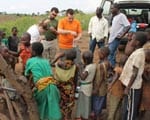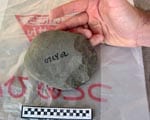Radioactivity interferes with our ability to observe dark matter. A banana would be more radioactive than the materials we use for our experiment. — Jodi Cooley
The XIA Alpha Particle Counter sounds like it belongs in a science fiction movie. In reality it’s housed in a clean room operated by SMU’s Department of Physics, where SMU physicist Jodi Cooley and her students rely on it as part of their search for dark matter.
Cooley is a member of the global scientific consortium called SuperCryogenic Dark Matter Search (SuperCDMS). SuperCDMS is searching for elusive dark matter — the “glue” that represents 85 percent of the matter in our universe but which has never been observed.
SuperCDMS operates a particle detector in an underground abandoned mine in Minnesota. The detector is designed to capture a glimpse of WIMPS (Weakly Interacting Massive Particles), which some physicists theorize constitutes dark matter. WIMPS are particles of such low mass that they rarely interact with ordinary matter, making them extremely difficult to detect.
Now SuperCDMS plans to build a larger and even more sensitive detector for deployment at SnoLab, an even deeper underground mine near Ontario, Canada. To prepare, Cooley’s team will advance analysis techniques and help determine ultra pure construction materials to increase the detector’s sensitivity to dark matter interactions.
In testing materials, Cooley’s team measures how much radon or radioactivity occurs as background interference on a sample. SuperCDMS scientists try to minimize background interference to improve the chances of observing WIMPS.
To assess background, Cooley and her team rely on the high-tech XIA Alpha Particle Counter. SMU is one of only five entities in the world to house the XIA.
An assistant professor in the SMU Department of Physics, Cooley was recently recognized by the National Science Foundation with its prestigious Faculty Early Career Development Award. The NSF awarded Cooley a 5-year, $1 million research grant toward her SuperCDMS dark matter research. Students assisting in the XIA counting include Bedile Karabuga, doctoral student, and Mayisha Nakib, first year.
What’s the importance of background?
Cooley: For people who are older, they’ll remember back before digital TVs to analog TVs. Sometimes you’d turn to a channel and it would be fuzzy, so you’d play with the antenna, play with the contrast. That’s sort of the same thing going on in our detectors.
We want our detectors to produce a clear image of dark matter. But we have a lot of background or static and fuzz getting in the way. So we have a bag of tricks for removing that static or fuzz to help us see if the dark matter interacts in our detectors.
Just like the TV, we don’t want to start with a channel that’s completely snow, but a channel that’s sort of coming in. You want to reduce the background as much as possible. That’s what we’re doing with SuperCDMS. So the studies we’re doing are trying to reduce the background around the instrument by selecting ultra pure material with which to construct the instrument.
The background is from radioactivity, cosmic rays, and just from the fact there are particles around us all the time. So we try to minimize them as much as possible. Even our finger essentially would introduce radioactivity onto our detectors.
How important are ultra pure materials?
Cooley: This is very critical. We’re looking for a very rare occurrence: dark matter interacting in these detectors. Radioactivity interferes with our ability to observe dark matter. The radioactivity in most materials is much higher than the rate of dark matter interactions. So we try to get the purest materials we can find. To describe how pure a material we’re seeking, it helps to know that a banana would be more radioactive. Touching the detectors with our fingers, because our fingers have potassium on them, would ruin the experiment. We’re looking for very trace levels of radioactivity in materials.
To select the best, we try to count the rate of radioactive decays in materials. Our SuperCDMS collaboration has several types of counters, and different ways and techniques to calculate a material’s radioactivity. Here at SMU in the LUMINA Lab — Laboratory for Ultra Pure Material Isotope and Neutron Assessment — we have the XIA counter, which we’ve named Peruna.
Where do neutrons enter the picture?
Cooley: Neutrons are nearly impossible to distinguish from dark matter in our detectors. They also form background. My postdoctoral researcher Silvia Scorza and SMU graduate student Hang Qiu are both characterizing neutrons that come from the materials. That’s primarily done through simulations. So once we have rates of these types of interactions, we can generate through simulations what this would mean for the experiment. That helps us determine the right materials.
How does the XIA work?
Cooley: The instrument is essentially a drift chamber. We put a material sample on the surface of a tray in the chamber. An electric field goes through the instrument. When the charged particles give off radioactivity in the electric field they drift upward, and then we can measure the energy of the particles and the number of them from any given sample.
Can that be challenging?
Cooley: It’s not trivial. There are subtleties in the instrument. In trying to understand the data and trying to get an accurate count off certain types of materials such as plastics, we have to decide on certain conditions, like how long should the purging process last.
Why is there more than one dark matter experiment in the world?
Cooley: Dark matter is an important question and there are a variety of experiments using different techniques to solve the question. It’s not enough for one technique and one experiment to say they’ve made a discovery. It always has to be verified and looked at by another experiment, independently, with a different technique. If different techniques and different instruments prove the finding, then you can have a lot more confidence in the result. — Margaret Allen





 Public health insurance provides insured infants better, less costly care than private plans
Public health insurance provides insured infants better, less costly care than private plans A mathematical model determines which nations are more stable and which are more likely to break up
A mathematical model determines which nations are more stable and which are more likely to break up Indian, Vietnamese immigrants become American over time through civic activities, say anthropologists
Indian, Vietnamese immigrants become American over time through civic activities, say anthropologists






 SMU to help solve dangerous refugee water issues
SMU to help solve dangerous refugee water issues









